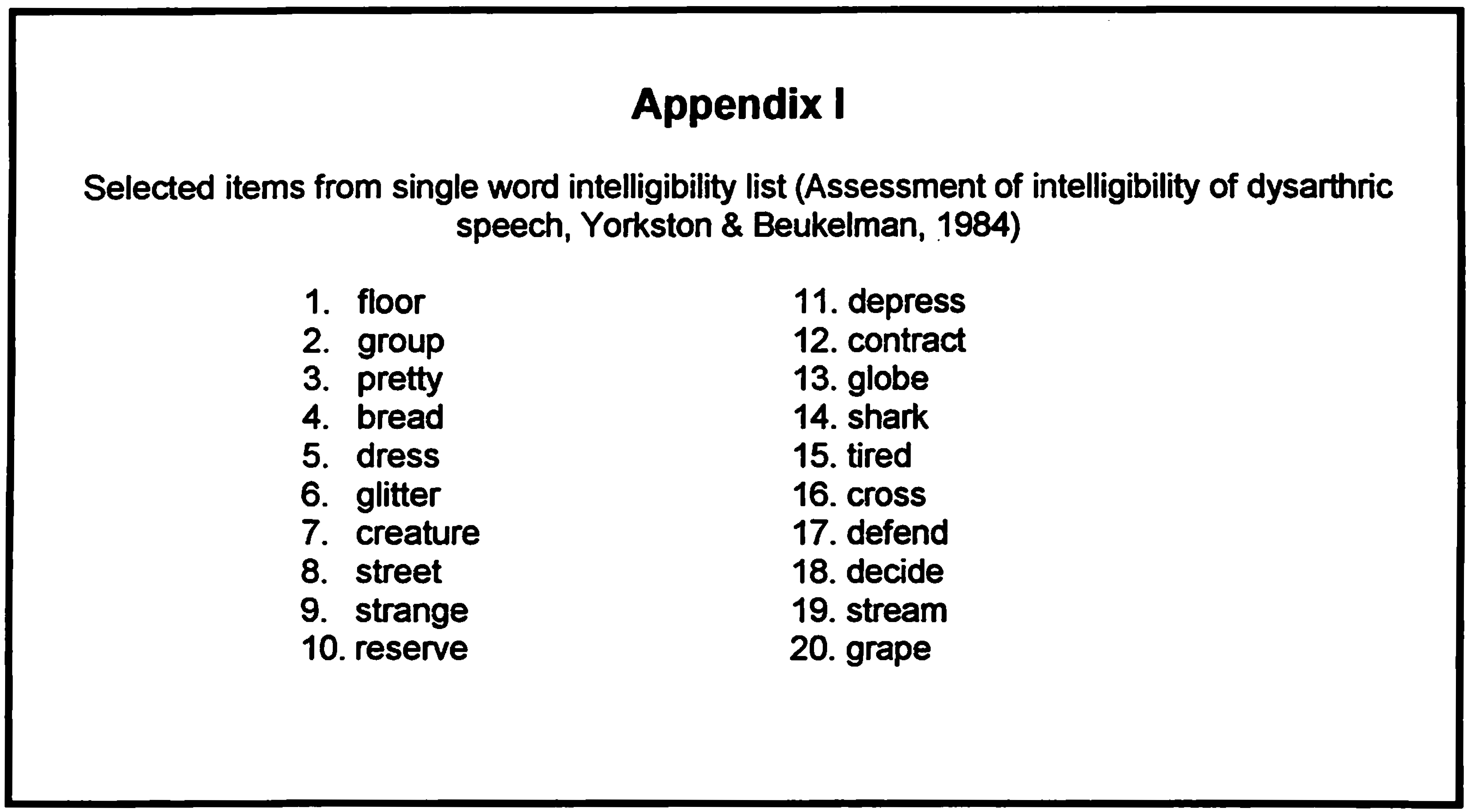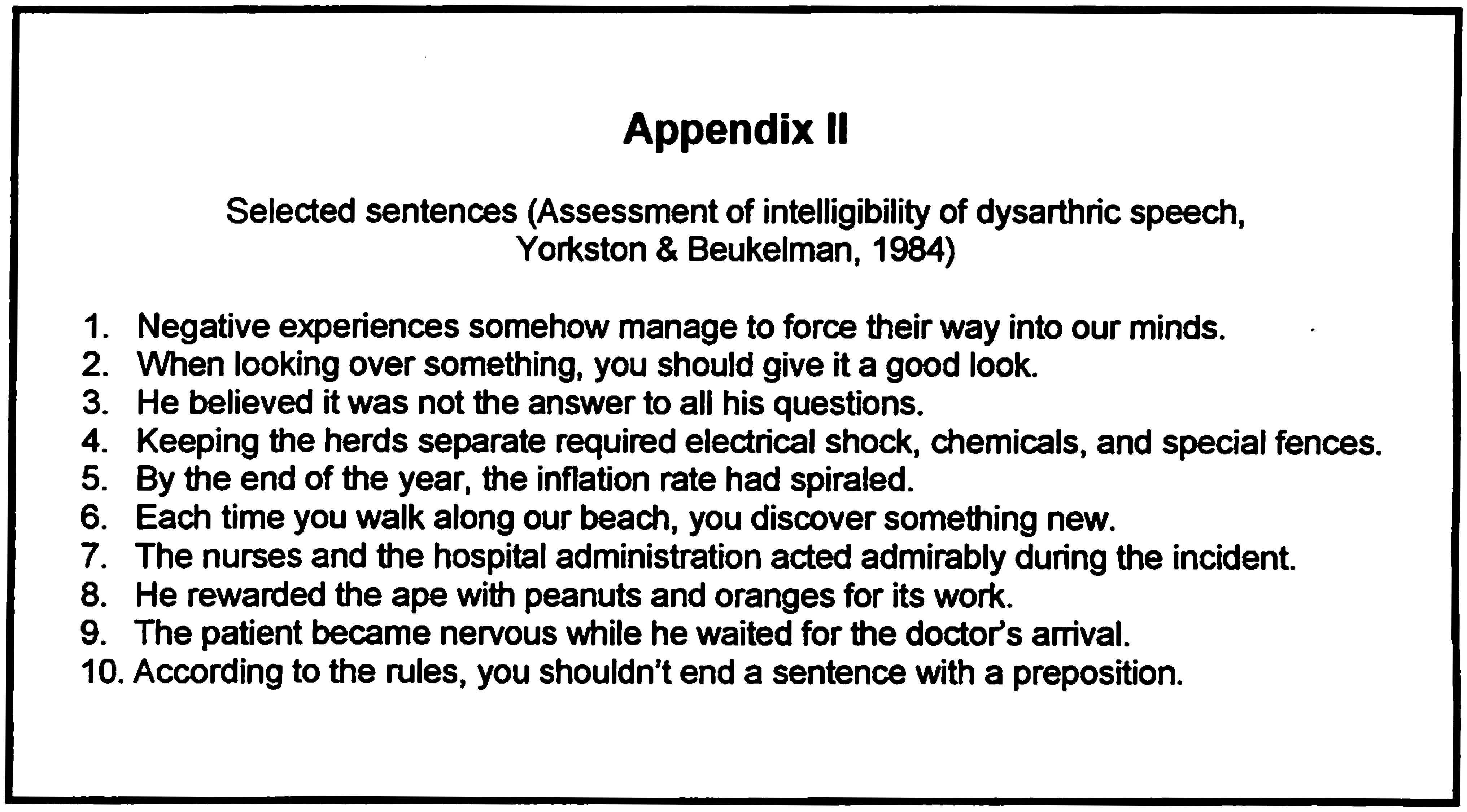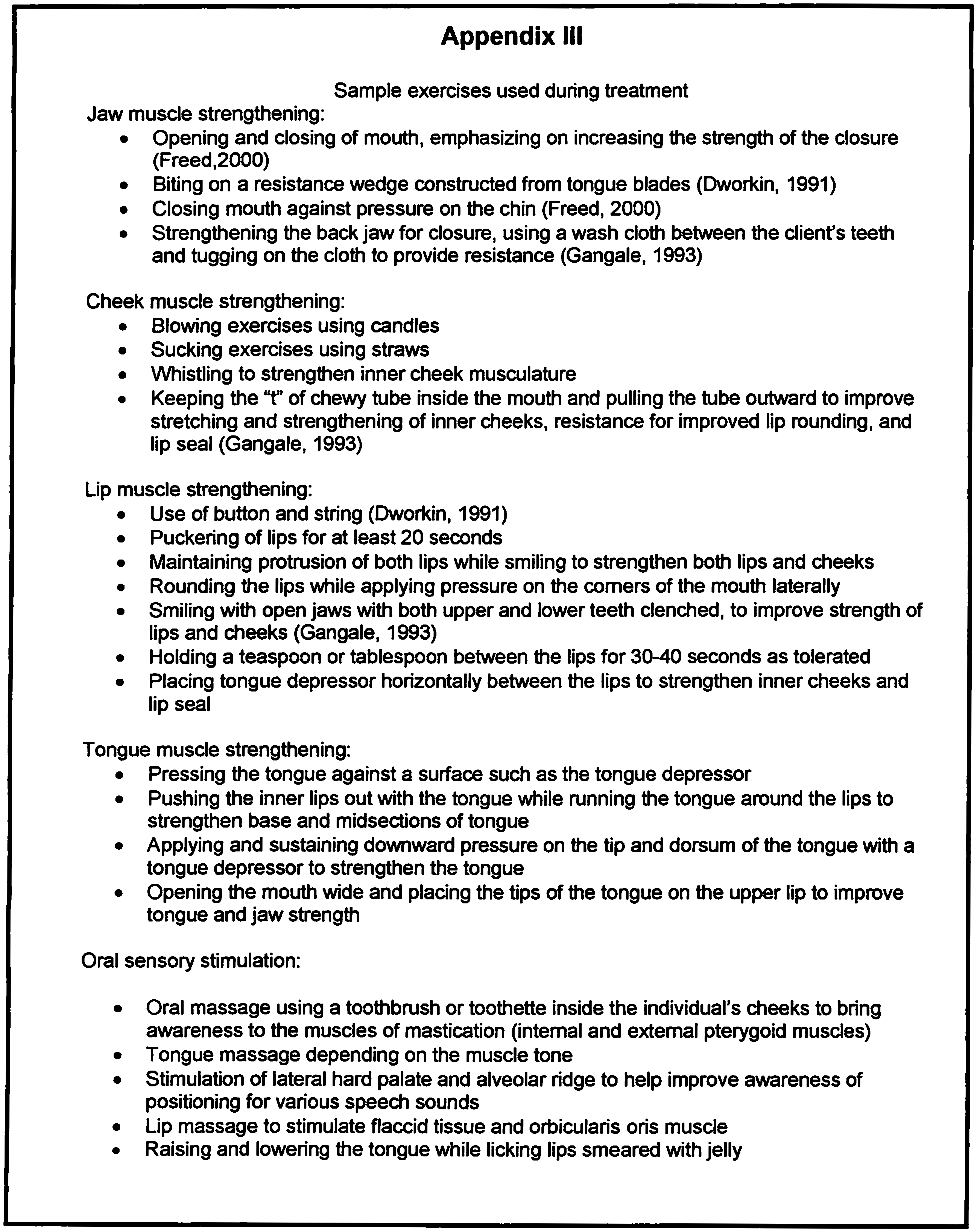Orofacial Myofunctional Therapy in Dysarthria: A Study on Speech Intelligibility
Abstract
:INTRODUCTION
METHOD
Participants
Baseline measures
Speech testing
Treatment procedures
RESULTS AND DISCUSSION


CONCLUSIONS AND CLINICAL IMPLICATIONS
LIMITATIONS AND FUTURE RESEARCH
Appendix A. Selected items from single word intelligibility list (Assessment of intelligibility of dysarthric speech, Yorkston & Beukelman, 984)

Appendix B. Selected sentences (Assessment of intelligibility of dysarthric speech, Yorkston & Beukelman, 1984)

Appendix C. Sample exercises used during treatment

References
- Adams, S. G. 1997. Hypokinetic dysarthria in Parkinson's disease. In Clinical management of sensory motor speech disorders. Edited by M. R. McNeil. New York: Thieme Medical Publishers, pp. 261–85. [Google Scholar]
- American Speech and Hearing Association. 1989. Report: Ad Hoc Committee on Labial-Lingual Posturing Function. ASHA, 92–4. [Google Scholar]
- American Speech and Hearing Association. 1991b. The role of Speech—Language—Pathologist in management of oral myofunctional disorders. ASHA 33 Suppl. 5: 7. [Google Scholar]
- American Speech-Language-Hearing Association. 1993. Orofacial myofunctional disorders: knowledge and skills. ASHA 35 Suppl. 10: 21–3. [Google Scholar]
- Aronson, E. 1997. The Dysarthria examination. Rochester, MN: Mentor Seminars. [Google Scholar]
- Bacha, S. M., and C. F. Rispoli. 1999. Myofunctional therapy: brief intervention. International Journal of Orofacial Myology 25: 3747. [Google Scholar]
- Benkert, K. K. 1997. The effectiveness of orofacial myofunctional therapy in improving dental occlusion. International Journal of Orofacial Myology 23: 35–46. [Google Scholar] [CrossRef]
- Bigenzahn, W., L. Fischman, and U. Mayrhofer-Krammel. 1992. Myofunctional therapy in patients with orofacial dysfunctions affecting speech. Folia Phoniatrica 44, 5: 238–44. [Google Scholar] [CrossRef] [PubMed]
- Cannito, M. P., and T. P. Marquardt. 1997. Ataxic dysarthria. In Clinical management of sensory motor speech disorders. Edited by M. R. McNeil. New york: Theme Medical Publishers, pp. 217–47. [Google Scholar]
- Darley, F. L., A. E. Aronson, and J. R. Brown. 1975. Motor speech disorders. Philadelphia: W.B. Saunders. [Google Scholar]
- Duffy, J. R. 1995. Motor speech disorders: Substrates, differential diagnosis, and management. St Louis: Mosby. [Google Scholar]
- Year Book.
- Dworkin, J. P. 1991. Motor speech disorders: A treatment guide. St. Louis: Mosby. [Google Scholar]
- Enderby, P. M. 1983. Frenchay dysarthria assessment. Austin, TX: Pro-Ed. [Google Scholar]
- Fletcher, S. G. 1972. Time-by-count measurement of diadochokinetic syllable rate. Journal of Speech and Hearing Research 15: 765–70. [Google Scholar] [CrossRef] [PubMed]
- Folstein, M. F., S. E. Folstein, and P. R. Mc Hugh. 1975. Mini-mental state. Journal of Psychiatric Research 12: 189198. [Google Scholar] [CrossRef] [PubMed]
- Freed, D. B. 2000. Motor speech disorders. United States: Singular Thompson Learning. [Google Scholar]
- Gangale, D. C. 1993. The source for oral-facial exercises. East Moline, IL: Lingua systems. [Google Scholar]
- Hahn, V., and H. Hahn. 1992. Efficacy of oromyofunctional therapy. International Journal of Orofacial Myology 18: 2123. [Google Scholar]
- Hanson, M. L. 1988. Orofacial myofunctional disorder. Guidelines for assessment and treatment. International Journal of Orofacial Myology 14: 27–32. [Google Scholar] [CrossRef]
- Kellum, G. D. 1994. Overview of Orofacial mycology. In Orofacial myology: Beyond tongue thrust. Edited by M. M. Ferketic and K. Gardner. Rockville, MD: American Speech-Language-Hearing Association. [Google Scholar]
- Landis, C. F. 1994. Applications of orofacial myofunctional techniques to speech therapy. International Journal of Orofacial Myology 20: 40–51. [Google Scholar] [CrossRef]
- Langmore, S. E., and M. E. Lehman. 1994. Physiologic deficits in orofacial system underlying dysarthria in amyotrophic lateral sclerosis. Journal of Speech & Hearing Research 37, 1: 28–37. [Google Scholar]
- Myers, P. S. 1997. Right hemisphere syndrome. In Aphasia and related neurogenic language disorders, Edited by L. L. LaPointe. , 2nd ed. New York: Thieme, pp. 201–25. [Google Scholar]
- Ray, J. 2002. Treating phonological disorders in a multilingual child: A case study. American Journal of Speech-Language Pathology 11, 3: 305–315. [Google Scholar]
- Robertson, S. 2001. The efficacy of orofacial and articulation exercises in dysarthria following stroke. International Journal of Language & Communication disorders 36: 292–7. [Google Scholar]
- Rosenbek, J., and L. L. Lapointe. 1978. The dysarthrias: Description, diagnosis and treatment. In Clinical management of neurogenic communicative disorders. Edited by D. F. John. Boston: Little, Brown, pp. 351–10. [Google Scholar]
- Rosenbek, J. C., and L. L. LaPointe. 1985. The dysarthrias: Description, diagnosis, and treatment. In Clinical management of neurogenic communication disorders. Edited by D. F. Johns. Boston: Little, Brown. [Google Scholar]
- Schievano, D., R. M. P. Rontani, and F. Berzin. 1999. Influence of myofunctional therapy on the perioral muscles: Clinical and electromyographic evaluations. Journal of Oral Rehabilitation 26, 7: 564–569. [Google Scholar] [CrossRef] [PubMed]
- Wohlert, A. B., and V. L. Hammen. 2000. Lip muscle activity related to speech rate and loudness. Journal of Speech, Language & Hearing Research 43, 5: 1229–39. [Google Scholar]
- Yorkston, K., and D. Beukelman. 1984. Assessment of intelligibility of dysarthric speech. Oregon: C.C. Publications, Inc. [Google Scholar]
- Yorkston, K. M., D. R. Beukelman, and K. R. Bell. 1988. Clinical management of dysarthic speaker. Austin, TX: Pro-Ed. [Google Scholar]
- Ziegler, W. 2002. Task-related factors in oral motor control: Speech and oral diadochokinesis in dysarthria and apraxia of speech. Brain & Language 80: 556–75. [Google Scholar]
- Ziegler, W., and K. Wessel. 1996. Speech timing in ataxic disorders: Sentence production and rapid repetitive articulation. Neurology 47: 208–14. [Google Scholar] [CrossRef] [PubMed]
© 2002 by the author. 2002 Ray, J.
Share and Cite
Ray, J. Orofacial Myofunctional Therapy in Dysarthria: A Study on Speech Intelligibility. Int. J. Orofac. Myol. Myofunct. Ther. 2002, 28, 39-48. https://doi.org/10.52010/ijom.2002.28.1.3
Ray J. Orofacial Myofunctional Therapy in Dysarthria: A Study on Speech Intelligibility. International Journal of Orofacial Myology and Myofunctional Therapy. 2002; 28(1):39-48. https://doi.org/10.52010/ijom.2002.28.1.3
Chicago/Turabian StyleRay, Jayanti. 2002. "Orofacial Myofunctional Therapy in Dysarthria: A Study on Speech Intelligibility" International Journal of Orofacial Myology and Myofunctional Therapy 28, no. 1: 39-48. https://doi.org/10.52010/ijom.2002.28.1.3
APA StyleRay, J. (2002). Orofacial Myofunctional Therapy in Dysarthria: A Study on Speech Intelligibility. International Journal of Orofacial Myology and Myofunctional Therapy, 28(1), 39-48. https://doi.org/10.52010/ijom.2002.28.1.3




